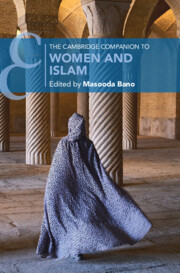Refine search
Actions for selected content:
13 results

Veiling in the Late Antique World
-
- Published online:
- 26 November 2025
- Print publication:
- 18 December 2025
Veiling in rural Bangladesh: women’s rights consciousness, choice, and subjectivity
-
- Journal:
- Politics and Religion , First View
- Published online by Cambridge University Press:
- 24 October 2025, pp. 1-19
-
- Article
-
- You have access
- Open access
- HTML
- Export citation
1 - Daddy Issues
-
- Book:
- Türkiye, Iran, and the Politics of Comparison
- Published online:
- 21 September 2025
- Print publication:
- 09 October 2025, pp 30-74
-
- Chapter
- Export citation
3 - Veiling and Restrictions on Sexual Liberty
- from Part I - Logic of Classical Reasoning
-
-
- Book:
- The Cambridge Companion to Women and Islam
- Published online:
- 12 April 2025
- Print publication:
- 17 April 2025, pp 85-105
-
- Chapter
- Export citation

The Cambridge Companion to Women and Islam
-
- Published online:
- 12 April 2025
- Print publication:
- 17 April 2025
Chapter 6 - Reverence
-
- Book:
- Protestant Bodies
- Published online:
- 20 February 2025
- Print publication:
- 27 February 2025, pp 264-286
-
- Chapter
- Export citation
7 - Rites of Marriage
- from Part III - Marriage Rites in Byzantine Liturgical Manuscripts
-
- Book:
- Marriage in Byzantium
- Published online:
- 01 May 2025
- Print publication:
- 23 January 2025, pp 241-309
-
- Chapter
- Export citation
Reputation-surveillance model of mate guarding: community size and religious veiling
-
- Journal:
- Evolutionary Human Sciences / Volume 6 / 2024
- Published online by Cambridge University Press:
- 30 October 2024, e37
-
- Article
-
- You have access
- Open access
- HTML
- Export citation
8 - The Marginalization of Islam
- from Part III - Religious Repression
-
- Book:
- Freedoms Delayed
- Published online:
- 20 July 2023
- Print publication:
- 20 July 2023, pp 133-146
-
- Chapter
- Export citation
6 - Modernism and the Politics of Dress
- from Part II - The Wider Middle East
-
- Book:
- Social Histories of Iran
- Published online:
- 26 January 2021
- Print publication:
- 28 January 2021, pp 235-276
-
- Chapter
- Export citation
1 - Introduction
-
- Book:
- Trust and the Islamic Advantage
- Published online:
- 31 August 2020
- Print publication:
- 03 September 2020, pp 1-18
-
- Chapter
- Export citation
18 - ‘Knocking Her Teeth out with a Stone’: Violence against Women in Ancient Greece
- from Part III - Intimate and Collective Violence
-
-
- Book:
- The Cambridge World History of Violence
- Published online:
- 13 March 2020
- Print publication:
- 26 March 2020, pp 380-399
-
- Chapter
- Export citation
Differences in vitamin D status and calcium metabolism in Saudi Arabian boys and girls aged 6 to 18 years: effects of age, gender, extent of veiling and physical activity with concomitant implications for bone health
-
- Journal:
- Public Health Nutrition / Volume 15 / Issue 10 / October 2012
- Published online by Cambridge University Press:
- 21 February 2012, pp. 1845-1853
-
- Article
-
- You have access
- HTML
- Export citation
